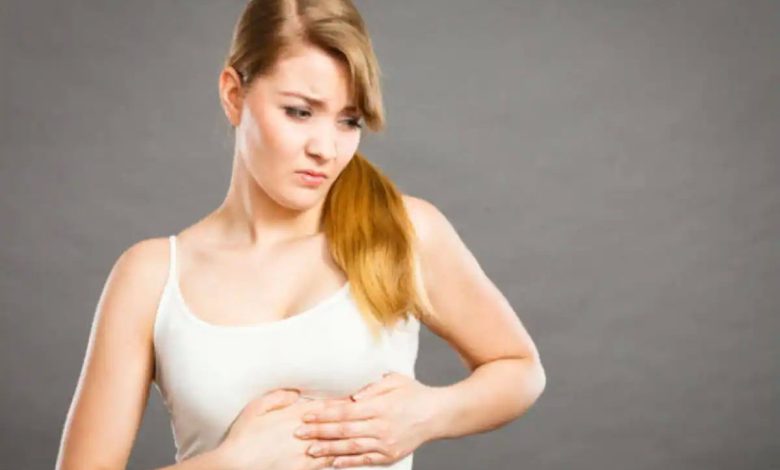Premenstrual breast changes: what is this, causes, symptoms, diagnostics, treatment, prevention

Premenstrual breast changes; Premenstrual tenderness and swelling of the breasts; Breast tenderness – premenstrual; Breast swelling – premenstrual
Premenstrual breast changes: what is it and how to treat?
Premenstrual breast changes is a general term for a series of cyclical physical changes in a woman's breasts., that take place before, during and after her menstrual cycle. It's not a sickness or a disease, and the expected normal occurrence, associated with hormonal fluctuations. Premenstrual breast changes may include breast tenderness, the severity of the, enlargement and swelling. Although sometimes it's inconvenient, it's mostly harmless, and changes often pass within a day or two.
Causes of premenstrual breast changes
Premenstrual breast changes are caused by an increase and decrease in hormone levels., primarily estrogen and progesterone, which are released during the ovulation phase of the menstrual cycle. Estrogen and progesterone work together to prepare the body for pregnancy and help regulate the menstrual cycle.. During the ovulation phase, these hormones cause the breasts to swell., making it fuller and more sensitive.
Symptoms of premenstrual breast changes
Primary symptoms of premenstrual breast changes include breast tenderness, completeness, swelling and heaviness. Breasts may look and feel bigger, and nipples can be tight. Pain can range from mild to severe and is localized in the chest, chest or armpit. Other symptoms may include nausea, headache, bloating and fatigue.
When to contact a healthcare professional
Most cases of premenstrual breast changes are harmless., and symptoms usually disappear within a few days. But, if the pain does not go away or if any other symptoms worsen, see a doctor for treatment. It is also important to see a doctor, if there are any signs of infection, such as redness, fever or discharge.
Diagnosis of premenstrual breast changes
Since premenstrual breast changes are not considered a disease, they are usually not diagnosed by a doctor. Nonetheless, a physical exam may be done to check for infection or other signs of illness. Besides, doctor can ask questions about symptoms and do tests, to rule out any underlying medical problems.
Treatment of premenstrual breast changes
Premenstrual breast changes do not require medical treatment, but there are some homemade and over the counter remedies, which can help relieve symptoms. These include taking ibuprofen or other anti-inflammatory drugs, applying a cold compress, wearing a supportive bra and doing light exercise to reduce muscle tension in the chest and upper body.
Home treatment for premenstrual breast changes
There are several home treatments, which can be used to reduce the discomfort of premenstrual breast changes. These include:
- Wearing a comfortable supportive bra or sports bra.
- Take a warm shower or bath.
- Applying a cold compress or cold compress to the chest.
- Doing light exercise, such as walking or yoga, to relieve tension in the chest and shoulders.
- Using a heating pad or taking a hot bath to relieve pain or discomfort.
- Drink plenty of fluids, to reduce bloating.
- Eat a healthy diet and avoid caffeine, alcohol and sugar.
- Application of relaxation techniques, such as deep breathing or meditation.
Prevention of premenstrual breast changes
Since premenstrual breast changes are a normal bodily process, cannot be completely prevented. Nonetheless, there are some steps, you can take, to reduce the severity of symptoms and make them easier to treat. These include a balanced diet, giving up caffeine, alcohol and sugar, regular exercise and relaxation practices. It is also important to wear a supportive bra and use cold compresses or hot baths if necessary..
Conclusion
Premenstrual breast changes are a normal bodily process., occurring during the menstrual cycle. This is usually breast tenderness., edema, fullness and heaviness. Although sometimes it's annoying, in most cases they are harmless and do not require treatment. But, if symptoms worsen or do not go away, it is important to see a doctor. Taking such measures, how to wear a support bra, giving up caffeine, alcohol and sugar, maintaining a balanced diet and applying relaxation techniques, may help reduce the severity of symptoms.
Used sources and literature
American College of Obstetricians and Gynecologists website. Dysmenorrhea: painful periods. www.acog.org/patient-resources/faqs/gynecologic-problems/dysmenorrhea-painful-periods. Updated January 2022. Accessed August 12, 2022.
Expert Panel on Breast Imaging; Jokich PM, Bailey L, et al. ACR appropriateness criteria breast pain. J Am Coll Radiol. 2017;14(5S):S25-S33. PMID: 28473081 pubmed.ncbi.nlm.nih.gov/28473081/.
Mendiratta in, Lentz GM. Primary and secondary dysmenorrhea, premenstrual syndrome, and premenstrual dysphoric disorder: etiology, diagnosis, management. In: Gershenson DM, Lentz GM, Crazy FOUR, Lobo RA, eds. Comprehensive Gynecology. 8th ed. Philadelphia, PA: Elsevier; 2022:chap 35.
Sandadi S, Rock DT, Orr JW, Crazy FOUR. Breast diseases: detection, management, and surveillance of breast disease. In: Gershenson DM, Lentz GM, Crazy FOUR, Lobo RA, eds. Comprehensive Gynecology. 8th ed. Philadelphia, PA: Elsevier; 2022:chap 15.
Sasaki J, Gelezke a, Kass RB, Klimberg VS, Copeland EM, Bland KI. Etiology and management of benign breast disease. In: Bland KI, Copeland EM, Klimberg VS, Gradishar WJ, eds. The Breast: Comprehensive Management of Benign and Malignant Diseases. 5th ed. Philadelphia, PA: Elsevier; 2018:chap 5.
